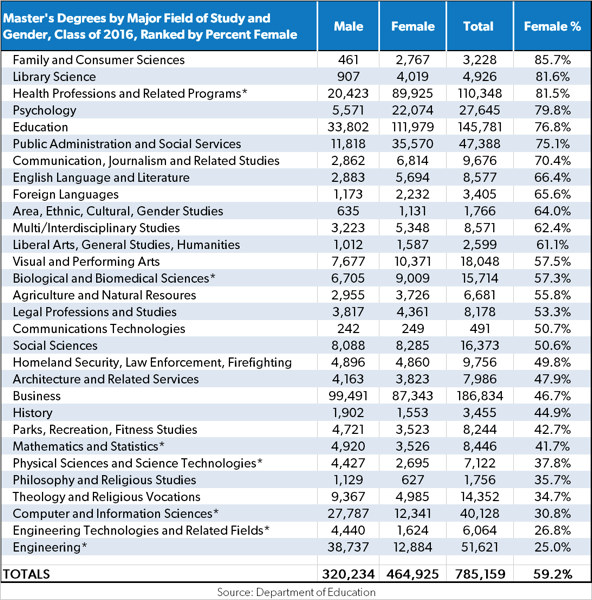You will notice that other than STEM fields, women dominate men in Master’s Degrees.
So why all the focus on women being underrepresented in Silicon Valley jobs (69.4% of men have advanced degrees in CS)?
But no similar outcry for the the overwhelming overrepresentation of women in Family and Consumer Sciences (86%), Library Science (82%), etc?

Economics professor Mark J. Perry has the relevant notes:
Following my post yesterday for bachelor’s degrees by field and gender in 2016, the table above shows the number of master’s degrees by major field of study and gender for the Class of 2016, ranked by the female share of each field (based on recently released Department of Education data here). A few observations:
1. Overall, women earned 59.2% of all master’s degrees in 2016, which means there were 145 women graduating from graduate school with a master’s degree that year for every 100 men. It also reflects a whopping 31% gender master’s degree gap for men, who earned only 320,234 master’s degrees in 2016 compared to 464,925 degrees earned by women (320,234 / 464,925 = 0.69, or 69 degrees for men per every 100 for women = gender master’s degree gap of 31% for men).
2. Although data are not yet available for master’s degrees by field and gender in 2017, the Department of Education reported last month that women earned 477,792 and 59.4% of all master’s degrees last year compared to only 326,892 degrees for men, which increases the gender master’s degree gap for men to 31.6%. Women also now have an uninterrupted 36-year record of earning the majority of master’s degrees in the US that started back in 1981. The Class of 2017 was also noteworthy for being the 13th straight graduate class that had more than 59% female representation for earning master’s degrees – a milestone first reached by the Class of 2005.
3. Women earned more than 57% of master’s degrees in biology in 2016, which is one of the fields in the STEM area that we hear so much about in terms of female under-representation. And actually, if you include health professions as a STEM field (which BLS does, see hereand here), women earned a majority (55.1%) of STEM master’s degrees in 2016 (132,004 females vs. 107,439 males) for degrees in the seven STEM fields above marked with an asterisk (*). Or if you count just biology, mathematics, and physical sciences (e.g., chemistry, physics, etc.) women earn nearly half (49%) of those of those STEM degrees. It’s really only when you include engineering and computer science that men have an overall majority of STEM degrees.
4. Note the wide variation in degrees by gender shares. Women earn the large majority of degrees in 18 of the fields in the table above, including health professions (81.5%), psychology (79.8%), education (76.8%), public administration (75.1%), communication (70.4%), and English (66.4%) and men earn the large majority of degrees in engineering (75%), computer science (69.2%), and theology (65.3%).